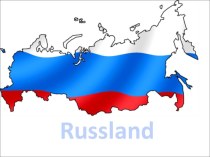- Главная
- Разное
- Бизнес и предпринимательство
- Образование
- Развлечения
- Государство
- Спорт
- Графика
- Культурология
- Еда и кулинария
- Лингвистика
- Религиоведение
- Черчение
- Физкультура
- ИЗО
- Психология
- Социология
- Английский язык
- Астрономия
- Алгебра
- Биология
- География
- Геометрия
- Детские презентации
- Информатика
- История
- Литература
- Маркетинг
- Математика
- Медицина
- Менеджмент
- Музыка
- МХК
- Немецкий язык
- ОБЖ
- Обществознание
- Окружающий мир
- Педагогика
- Русский язык
- Технология
- Физика
- Философия
- Химия
- Шаблоны, картинки для презентаций
- Экология
- Экономика
- Юриспруденция
Что такое findslide.org?
FindSlide.org - это сайт презентаций, докладов, шаблонов в формате PowerPoint.
Обратная связь
Email: Нажмите что бы посмотреть
Презентация на тему Microbial biotechnology
Содержание
- 2. What are microbes? Microbes are small single-celled
- 3. Eubacteria(Bacteria)Archaebacteria(Archaea)Eukaryota(Eukaryotes)Three Domains
- 4. Eubacteria Gram-negative and gram-positive prokaryotes Either autotrophs
- 5. Archea Ancient domain, but only recently identified
- 6. EukaryotesPredominately yeasts/molds, protists, algaeSac shaped cells that form sexual sporesExamples: Sacchromyces Penicillium Aspergillus Pichia
- 7. Commercial Uses of MicrobesProductsBioconversion/BiocatalysisAgricultureBioremediationOil/Mineral Recovery
- 8. Fermentation is a process for the production
- 9. http://www.wavebiotech.com/products/wave_bioreactor/system500/index.htmlhttp://www.pharmaceutical-technology.com/projects/lonza/lonza1.html15 000L Fermenter1000L Disposable Bag
- 10. Types of Products Produced in MicrobesAmino AcidsVitaminsFood AdditivesEnzymesRecombinant Protein DrugsAntibioticsFuelsPlastics
- 11. Enzyme: chymosin - the enzyme used to
- 12. 1928: Alexander Fleming discovered the first antibiotic.He
- 13. How Are Microbes Modified?Artifical SelectionRecombiant DNAMetabolic Engineering
- 14. Transgenic microbes are created when cDNAs for
- 15. Enzyme/Drug
- 16. Metabolic Engineering, manipulation of pathways within an
- 17. The microbe is forced to produce alanine at higher than normal amounts
- 18. Carotenoid production in E.coli cells
- 19. Fermentation ProductsEnzymes
- 20. Enzymes, the most common product produced by
- 21. Enzyme Name GE Organism Use (examples) -acetolactate bacteria Removes
- 22. Detergent Enzymes
- 23. Detergents are the largest application of industrial
- 24. Subtilisin, a protease used in laundry detergentsThe
- 25. Directed evolution is the most recent tool
- 26. Subtilisin normally functions in aqueous solutionMutations were
- 27. Enzymes for Feed
- 28. Enzymes are used in animal feed to
- 29. Where do the genes for these enzymes come from?Nature is still an important source (Gene Prospecting)~
- 30. Recombinant DrugsBesides antibiotics which are derived from
- 31. 1982, FDA approves the first recombinant protein
- 32. Product Microbe PurposeInsulin E. coli Diabetes treatmentInterleukin-2 E. coli Cancer/immune system stimulantEGF E. coli wound healingInterferons E. coli/yeast Cancer/virus treatmentsProurokinase E.coli/yeast Anticoagulant/heart attacksCSF E. coli/yeast Immune stimulantTaxol E. coli ovarian cancer
- 33. Other Products From MicrobesFuels, Plastics, Medications
- 34. Ethanol ProductionProduced via anaerobic fermentation by yeastCorn starch is hydrolyzed to glucose monomers
- 35. Problem with Corn Ethanol Ethanol contains 76000BTU/galTakes
- 36. PlasticsPolyhydroxyalkanoate (PHA) is a polymer made by
- 37. http://www2.unil.ch/ibpv/WWWPoirier/images/Fig2.jpg
- 38. BioconversionUtilization of microbes to modify a compoundUseful
- 39. starting productEnd products
- 40. Microbes and Agriculture
- 41. Frost damages many crops such as citrus
- 42. Some ice crystal nucleation is due to
- 43. A strain of P. syringae called “ice
- 44. Bacillus thuringiensis (Bt) is an aerobic spore-forming
- 45. http://www.bioc.cam.ac.uk/~dje1/
- 47. Bioremediation
- 48. Bioremediation is reclaiming or cleaning of contaminated
- 49. Bacteria are isolated based on their efficiency
- 50. What can be cleaned up using bioremediation? Oil spills Waste water Plastics Chemicals (PCBs) Toxic Metals
- 51. Oil/Wastewater Cleanup
- 52. BioremediationBacteria degrade organic matter in sewage.Bacteria degrade or detoxify pollutants such as oil and mercury
- 53. Microbes that digest hydrocarbons found throughout the
- 54. Exxon Valdez off the Coast of Alaskahttp://blogs.abcnews.com/photos/uncategorized/exxon_valdez.jpg
- 55. Before AfterSmaller scale cleanup is feasibleFor 3 months
- 56. Before AfterTreatment of domestic sewage or industrial wasteUtilizes
- 57. Plastic Degradation
- 58. 140 million tons of plastics are produced
- 59. ChemicalsPolychlorinated biphenyls (PCBs)
- 60. PCBs have low water solubility, good insulating
- 61. 1977, Monsanto (main producer) stops all PCB
- 62. Microbes that dehalogenate PCBs have been isolatedThis
- 63. Heavy Metal Clean up
- 64. Uranium processing has left contaminated groundwater sites
- 65. Biomining
- 66. Microbe assisted mining has gone on for
- 67. Cu2S not soluble CuSO4 is soluble
- 68. Commercial Bioleaching Tanks
- 70. Скачать презентацию
- 71. Похожие презентации



























































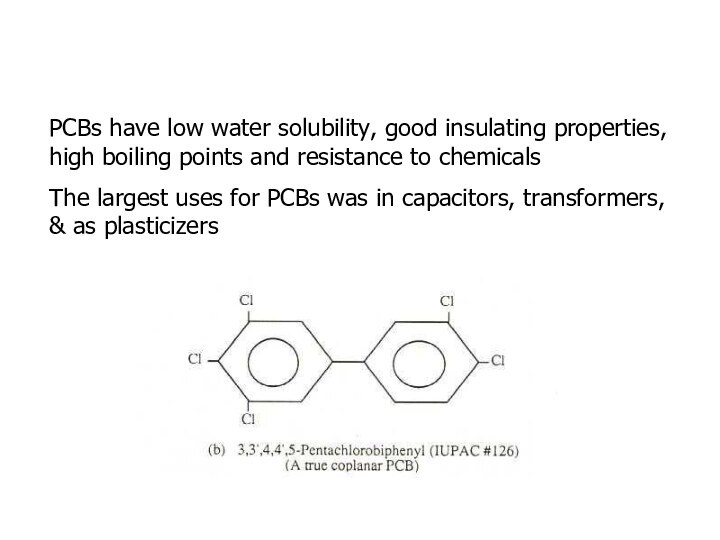

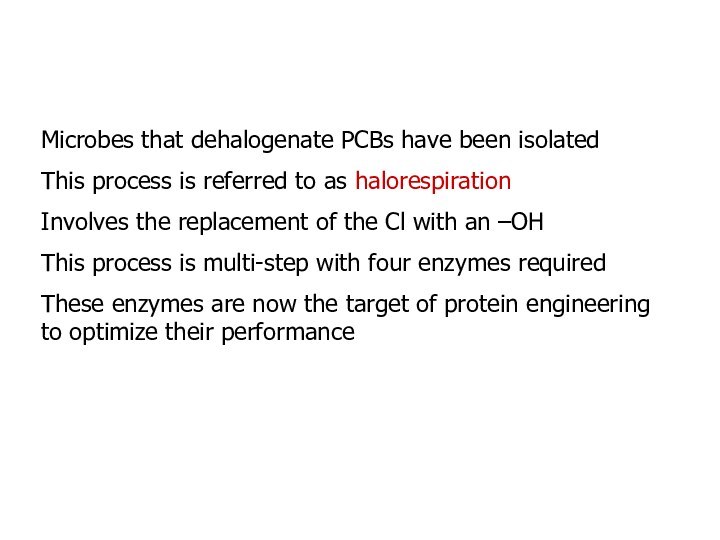



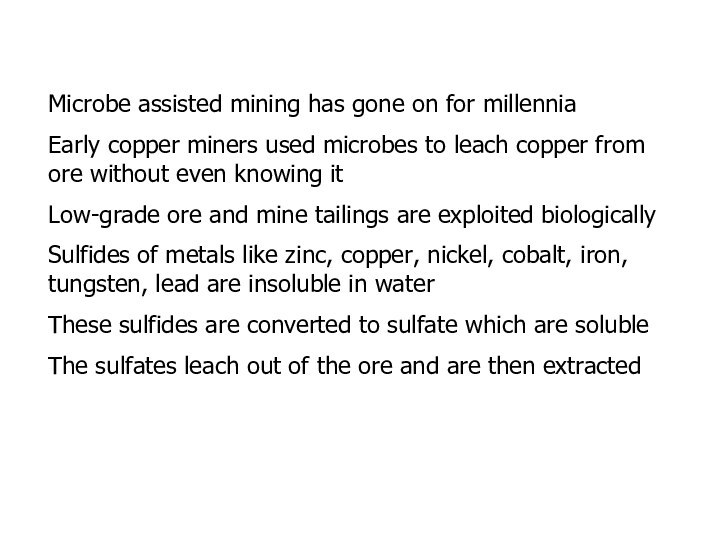

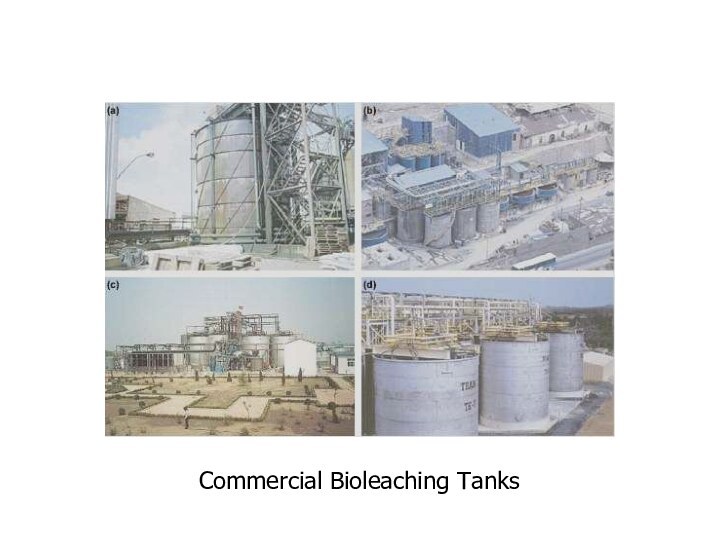


Слайд 2
What are microbes?
Microbes are small single-celled organisms
Either free-living or in colonies
any of the three domains
Слайд 4
Eubacteria
Gram-negative and gram-positive prokaryotes
Either autotrophs or
heterotrophs
Can be aerobic or anaerobic
Mesophiles
Examples:
E.
coliLactobacillus
Agrobacterium
Staphylococcus
Слайд 5
Archea
Ancient domain, but only recently identified
Through
DNA analysis they were determined to differ significantly from
eubacteriaFound predominantly in extreme environments (Extremophiles)
Thermophiles 50- 110°C
Psychrophiles 0- 20°C
Alkaliphiles pH>9
Halophiles 3- 20% salt
Methanogens use H2 + CO2 to produce CH4
Слайд 6
Eukaryotes
Predominately yeasts/molds, protists, algae
Sac shaped cells that form
sexual spores
Examples:
Sacchromyces
Penicillium
Aspergillus
Pichia
Слайд 7
Commercial Uses of Microbes
Products
Bioconversion/Biocatalysis
Agriculture
Bioremediation
Oil/Mineral Recovery
Слайд 8 Fermentation is a process for the production of
useful products through mass culture of single-cells
The end products
or the various intermediate products (metabolites) are siphoned off & purified for commercial usestirred tank reactor
Fermenter or Bioreactor
Слайд 9
http://www.wavebiotech.com/products/wave_bioreactor/system500/index.html
http://www.pharmaceutical-technology.com/projects/lonza/lonza1.html
15 000L Fermenter
1000L Disposable Bag
Слайд 10
Types of Products Produced in Microbes
Amino Acids
Vitamins
Food Additives
Enzymes
Recombinant
Protein Drugs
Antibiotics
Fuels
Plastics
Слайд 11
Enzyme: chymosin - the enzyme used
to curdle
milk products
Hormone: bST - bovine somatotropin; used to increase
milk productionExamples of bacterially-expressed proteins:
Слайд 12
1928: Alexander Fleming discovered the first antibiotic.
He observed
that Penicillium fungus made an antibiotic, penicillin, that killed
S. aureus.1940s: Penicillin was tested clinically and mass produced.
Original Penicillium moulds produced less than 10 units of penicillin per ml of fermentation broth (1943)
By 1955 Penicillium strains produced 8000 units/ml
Mutation with UV, mustard gas, and X-Ray, strain selection / culture improvement
Is this GMO?
Слайд 14 Transgenic microbes are created when cDNAs for the
protein product are cloned into expression vectors
Human genes inserted
into E. coliGenes from extremophiles are moved to mesophiles
Due to the ease in culturing of mesophiles
Mesophiles also have 5 to 10x higher growth rates
Recombinant DNA Microbes
Слайд 16 Metabolic Engineering, manipulation of pathways within an organism
to optimize the production of a compound
Done by turning
off particular genes, either through mutation or deletionProducts are also gained by altering the microbe’s environment
Слайд 20
Enzymes, the most common product produced by microbes
Overall
value of industrial enzymes is about $2.0 billion1
They are
found in many household items that you would never think to have a biotechnology componentEnzymes
1 2004 data
Слайд 21
Enzyme Name GE Organism Use (examples)
-acetolactate bacteria Removes bitter
substances decarboxylase from beer
-amylase bacteria Converts starch to simple sugar
Catalase fungi Reduces
food deteriorationChymosin bacteria or fungi Clots casein to make cheese
-glucanase bacteria Improves beer filtration
Glucose isomerase bacteria Converts glucose to fructose
Glucose oxidase fungi Reduces food deterioration
Lipase fungi Oil and fat modification
Maltogenic amylase bacteria Slows staling of breads
Pectinesterase fungi Improves fruit juice clarity
Protease bacteria Improves bread dough structure
xylanase (hemicellulase) bacteria or fungi Enhances rising of bread dough
http://www.geo-pie.cornell.edu/crops/enzymes.html
Слайд 23
Detergents are the largest application of industrial enzymes
Traditionally
these are lipolases, proteases & amylases
A recent innovation is
the addition of mannanaseThis enzyme aids in removing stains containing guar gum
These enzymes are engineered to improve stability in the presence of detergent, alkaline pH, and cold water
Слайд 24
Subtilisin, a protease used in laundry detergents
The recombinant
protein was engineered to remain active in the presence
of bleachBleach caused the oxidation of one amino acid (methionine) and the enzyme lost 90% of its activity
By replacing this amino acid with alanine, the engineered enzyme was no longer sensitive to oxidation
Слайд 25 Directed evolution is the most recent tool utilized
in the creation of new and better enzymes (&
other proteins)http://www.rsc.org/chemistryworld/Issues/2004/July/rational.asp
Слайд 26
Subtilisin normally functions in aqueous solution
Mutations were introduced
randomly throughout the structure of the enzyme
Only 0.1–1% of
the mutations were beneficial, but… Activity in 60% dimethylformamide was improved 256-fold
doi:10.1016/S1367-5931(02)00396-4
Слайд 28 Enzymes are used in animal feed to breakdown
cellulose (cellulase)
New use of enzymes (phytases) which breakdown phytic
acidThis allows better utilization of plant phosphorus stores
Allowing bone-meal to be removed from feeds
The latest generation of phytases are from fungus and have been engineered to survive high temperatures used during food processing
65% of poultry and 10% of swine feeds contain enzymes
Слайд 29 Where do the genes for these enzymes come
from?
Nature is still an important source (Gene Prospecting)
~
the microbes have been grown in pure culturesBut what if you cannot find the enzyme you want?
You engineer it…
In the 1980’s rational protein engineering was introduced as a way of optimizing enzymes
Слайд 30
Recombinant Drugs
Besides antibiotics which are derived from microorganisms
Protein
medicines are produced by inserting human genes into microbes
Слайд 31 1982, FDA approves the first recombinant protein drug,
human insulin produced by E. coli developed by Genentech
Today
there are >75 recombinant protein drugs approved by the FDA with 100s more being studiedCurrently the global market for recombinant protein drugs is $47.4 billion1
(2006)
Слайд 32
Product Microbe Purpose
Insulin E. coli Diabetes treatment
Interleukin-2 E. coli Cancer/immune system stimulant
EGF E. coli wound healing
Interferons E.
coli/yeast Cancer/virus treatments
Prourokinase E.coli/yeast Anticoagulant/heart attacks
CSF E. coli/yeast Immune stimulant
Taxol E. coli ovarian cancer
Слайд 34
Ethanol Production
Produced via anaerobic fermentation by yeast
Corn starch
is hydrolyzed to glucose monomers
Слайд 35
Problem with Corn Ethanol
Ethanol contains 76000BTU/gal
Takes ~98000BTU/gal
to produce from corn sugar
Gasoline contains 112000BTU/gal
Costs 22000BTU/gal to
extract and refineA BTU (British thermal unit) is defined as the amount of heat required to raise the temperature of one pound of water by one degree Fahrenheit
2004 3.4 billion gallons of ethanol were produced
U.S. consumes 140 billion gallons of gasoline/yr
Слайд 36
Plastics
Polyhydroxyalkanoate (PHA) is a polymer made by some
microbes as a way of storing carbon
Up to 80%
of the microbe’s biomass is plasticPHA is sold to make shampoo bottles in Germany, and disposable razors in Japan
The microbe Pseudomonas putida converts styrene to PHA
http://www2.unil.ch/ibpv/WWWPoirier/images/Fig1.jpg
Слайд 38
Bioconversion
Utilization of microbes to modify a compound
Useful when
multi-step chemical synthesis is expensive or inefficient
Often microbial conversion
is combined with traditional chemistry to reduce the steps necessaryThe most common use of bioconversion is in the synthesis of steroids such as hormones & corticosteroids
Слайд 41 Frost damages many crops such as citrus trees
& strawberries
When fruit freeze the ice crystals form
As the
plants thaws they are effectively turned to mushFrost damage to an orange leaf and fruit
Frost Damage
Слайд 42 Some ice crystal nucleation is due to bacterial
activity
Pseudomonas syringae promotes the development of ice at 0
to 2°CIf the bacteria are not present ice does not form until between –6 and –8°C
Слайд 43 A strain of P. syringae called “ice minus”
was developed
Plants were to be sprayed with the ice
minus strain This inhibits colonization by the “ice plus” (wild) strain
The EPA declared the new strain to be a pesticide
This made the review process lengthy and burdensome
The company thought it too expensive to pursue
However the “ice plus” strain has found a purpose…
Слайд 44 Bacillus thuringiensis (Bt) is an aerobic spore-forming bacterium
During sporulation produces insecticidal crystal protein (ICP), a toxin
(Cry)The toxin brakes down quickly in the environment
They have no toxicity to humans & there is no withholding period on produce sprayed with Bt
Cry toxins vary in their toxicity and specificity
Microbial Pesticides
Слайд 48 Bioremediation is reclaiming or cleaning of contaminated sites
using microbes or other organisms
This entails the removal, degradation,
or sequestering of pollutants &/or toxic wasteshttp://www.cleanearthltd.com/en/contamination_cleanup/index.php
Слайд 49 Bacteria are isolated based on their efficiency at
digesting & converting the waste
The bacteria are tested for
performance and safetyBacteria are placed back in the waste environment in high concentrations
The bacteria grow & in the process digest & convert the waste into CO2 and H20
Слайд 50
What can be cleaned up using bioremediation?
Oil
spills
Waste water
Plastics
Chemicals (PCBs)
Toxic Metals
Слайд 52
Bioremediation
Bacteria degrade organic matter in sewage.
Bacteria degrade or
detoxify pollutants such as oil and mercury
Слайд 53
Microbes that digest hydrocarbons found throughout the environment
These
naturally occurring microbes are utilized during a spill to
clean shore linesFertilizer is added to supply the nutrients phosphorus and nitrogen
This was approach was used after the Exxon Valdez
Stimulated the natural rate of biodegradation by 2 to 5x
There have yet to be any other instances of this being used on a large-scale
Слайд 54
Exxon Valdez off the Coast of Alaska
http://blogs.abcnews.com/photos/uncategorized/exxon_valdez.jpg
Слайд 55
Before After
Smaller scale cleanup is feasible
For 3 months nutrients
and microbes were sprayed on this field
After 11 months
the site was deemed clean6000yards3 petroleum conc. Before 4000ppm After 100ppm
Слайд 56
Before After
Treatment of domestic sewage or industrial waste
Utilizes aeration
to oxygenate allowing aerobic microbes to digest solid waste
Wastewater
Слайд 58 140 million tons of plastics are produced each
year
Traditional plastics are very stable and do not degrade
Some
plastics have been shown to be biodegradableStrains of bacteria have been isolated that breakdown:
Polyurethane
Polyvinyl alcohol
Nylon-66
The degradation pathways are currently under study
Слайд 60 PCBs have low water solubility, good insulating properties,
high boiling points and resistance to chemicals
The largest uses
for PCBs was in capacitors, transformers, & as plasticizers
Слайд 61
1977, Monsanto (main producer) stops all PCB production
Millions
of lbs of PCBs are still in place around
the worldThe stability properties that made PCBs so useful have allowed them to persist in the environment
Most people in industrialized countries have PCBs in their tissue
Слайд 62
Microbes that dehalogenate PCBs have been isolated
This process
is referred to as halorespiration
Involves the replacement of the
Cl with an –OHThis process is multi-step with four enzymes required
These enzymes are now the target of protein engineering to optimize their performance
Слайд 64 Uranium processing has left contaminated groundwater sites across
the United States and the world
Traditional “pump-and-treat” methods take
decades and expose workers to toxic levels of uraniumGeobacter to convert soluble uranium to insoluble uraninite
Uraninite stays put instead of mixing with water used for drinking or irrigation
The microbes are encouraged to multiply by injecting acetate
In ~50 days, 70% of the uranium is converted into uraninite
Слайд 66
Microbe assisted mining has gone on for millennia
Early
copper miners used microbes to leach copper from ore
without even knowing itLow-grade ore and mine tailings are exploited biologically
Sulfides of metals like zinc, copper, nickel, cobalt, iron, tungsten, lead are insoluble in water
These sulfides are converted to sulfate which are soluble
The sulfates leach out of the ore and are then extracted
